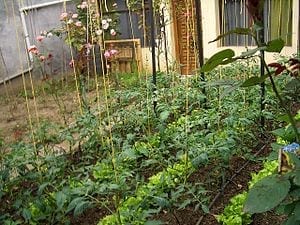My guess is that 100 years from now, lawns will be about as common as Hummers
The seed catalogs have arrived, and for the roughly 15 percent of Americans who appreciate the joys and rewards of growing some of their own crops, this is a more encouraging sign than Groundhog Day or even the reporting of pitchers and catchers to spring training.
Yet several times a year we hear of a situation like the one in Orlando, where the mayor claims to be striving to make his city green while his city harasses homeowners like Jason and Jennifer Helvenston for planting vegetables in their front yard, threatening to fine them $500 a day — for gardening. The battle has been raging for months, and the city’s latest proposal is to allow no more than 25 percent of a homeowner’s front yard to be planted in fruits and vegetables.
As if gardens were somehow an official eyesore, or inappropriate. (Jason Helvenston, my hero, said: “You’ll take my house before you take my vegetable garden.”) If you want to plant a lawn, that’s fine, though it’s a waste of water and energy, both petrochemical and human. Nor are lawns simply benign: many common lawn chemicals are banned in other countries, because most if not all are toxic in a variety of ways. My guess is that 100 years from now, lawns will be about as common as Hummers.
True, a lawn is a living, growing thing, a better carbon sink than concrete (though not as good as a vegetable garden or a meadow), and even more so if you leave the clippings in place, which also reduces the need for chemical fertilizer. And most people find a well-tended lawn pleasant-looking.
But when it comes to the eye of the beholder, weeds are the same thing as beauty: to a gardener, grass is a weed; a row of lettuce surrounded by dark, grassless soil a thing of beauty. To some gardeners, including me, dandelions are a crop.
The situation, then, is not black-and-white. A yard is not either unproductive and “beautiful” — as a lawn — or, as a garden, productive and “ugly.” Many of us can thrill to the look of dead stalks, and even enjoy watching them rot. This is a matter of taste, not regulation.
“In a way, that’s what these battles are about,” says Fritz Haeg, the Los Angeles artist who initiated Edible Estates and wrote the book of the same name (subtitled “Attack on the Front Lawn”). “They’re about reconsidering our basic value systems and ideas of beauty.”
They’re also about a relationship between us and nature. Lawns are an attempt to dominate and homogenize nature, something that hasn’t worked out very well. Gardens, however, especially urban ones, make visible “the intimate relationship between people, cities and food, constantly reminding us of the complexities and poetry of growing food and eating,” says Haeg. From which, just about everyone who’s thought about the subject agrees, we’ve all become alienated.
And small-scale suburban and urban gardening has incredible potential. Using widely available data, Roger Doiron of Kitchen Gardeners International estimates that converting 10 percent of our nation’s lawns to vegetable gardens “could meet about a third of our fresh vegetable needs at current consumption rates.”
via The New York Times – MARK BITTMAN
The Latest Streaming News: Lawns Into Gardens updated minute-by-minute
Bookmark this page and come back often
Latest NEWS
Latest VIDEO








